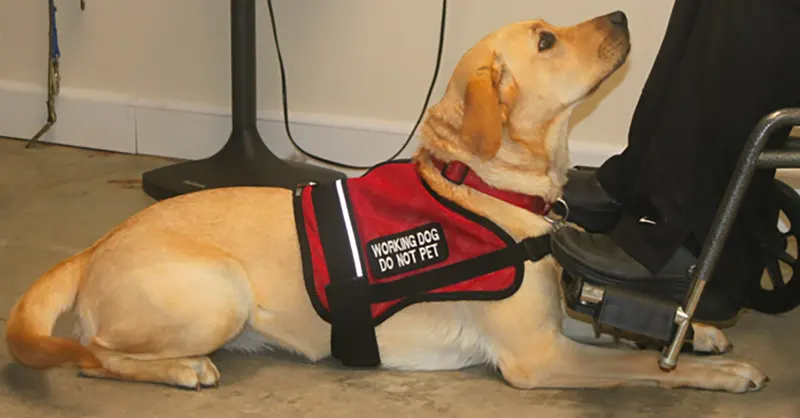Home Page › Blog › Emotional Support Dog Requirements
Emotional Support Dog Requirements

Are you confused when it comes to emotional support dog requirements? You’re not alone. There is a lot of information out there on this important subject, some of which is misleading or just plain false.
If you want to designate your dog as an emotional support dog (ESD), it’s important to understand all of the requirements, rules, and regulations.
In this post, we answer some of the most commonly asked questions about emotional support dogs/animals.
1. What is an emotional support dog?
An emotional support dog (ESD or emotional support animal, ESA) is a dog that is recommended by a licensed doctor, therapist, counselor, or social worker to help those that suffer from an emotional or mental health condition.
Emotional Support Dogs have rights that normal pets do not:
- An ESA has access to almost all types of housing regardless of no-pet policies. ESAs are protected under the Fair Housing Act so that they can live with their owners.
- Under this law, an ESA owner cannot be charged any fees for having an animal in their home.
2. Can I qualify for an emotional support dog?
You can qualify for an emotional support dog if you have an emotional or mental illness(es). If you suffer from one or more mental conditions listed below, you may qualify for an emotional support dog.
- Attention deficit disorder (ADD)
- Learning disorders
- Autism
- Generalized anxiety disorder (GAD)
- Gender dysphoria
- Bipolar disorder
- Cognitive disorders
- Depression
- Severe anxiety
- Post-traumatic stress disorder (PTSD)
It is up to a licensed healthcare professional to determine whether you have an eligible condition for owning an emotional support dog.
3. Emotional support dog training requirements
ESAs do not require specialized training, unlike service dogs, which require extensive training. Service dogs must perform specific tasks to aid in their handler’s disability.
While ESAs do not need any specialized training, they should still be well-behaved and under your control at all times. A landlord can kick out an emotional support dog if it is acting in an unsafe or destructive manner.
4. Emotional support dog registration requirements
Federal and state rules do not require you to register your emotional support dog. You also do not need a vest or ID card for your emotional support animal. Many ESA owners, however, choose to voluntarily register their animals and obtain ID cards and other accessories.
These items are helpful in buildings that normally don’t allow pets. They notified staff and other tenants that a legally protected assistance animal accompanies you. However, remember that your landlord can insist on seeing your ESA letter but not any other form of documentation.
5. Where to get an emotional support dog certificate
Many people think they need to obtain an ESA “certificate” to qualify their dog as an emotional support animal. They are often confusing a certificate with an ESA letter. You can obtain a certificate for your emotional support dog after getting an ESA letter, but a certificate alone will not qualify your dog as an ESA.
You must have an ESA letter from a licensed mental health professional confirming your need for an emotional support animal. An ESA letter should have the following:
- The ESA letter should be dated within one year of submission
- The ESA letter should be on your provider’s official letterhead
- The ESA letter should include the provider’s license number, date, and direct contact information
6. Emotional support dog vest options

Emotional support animals can live in “no-pets” apartments and condos without being charged rent or fees. An emotional support dog does not need to wear a special vest when on the premises.
However, some owners prefer to have one. The ESD vest is a great way to identify your canine as a legal assistance animal and will help prevent any confusion and questions you encounter from building staff and neighbors.
7. Can my ESD go into restaurants or markets with me?
No, emotional support dogs are not allowed in public places that prohibit pets. ESAs have rights under federal and state housing laws but not under the Americans with Disabilities Act. The only type of mental health assistance animal that has public access rights are psychiatric service dogs.
8. Are there breed or weight restrictions for emotional support dogs?
No, your emotional support dog can be of any size and breed. This rule even protects breeds that are commonly discriminated against, such as Pit Bulls or Dobermans. You can even have more than one emotional support animal if your therapist recommends it.
Emotional support dogs work
If you believe you or a loved one may benefit from an ESD, don’t hesitate to make an appointment with your mental health professional to start the process.
If you do not have access to a healthcare professional or are intimidated by the idea of reaching out for help, consider using an online service to get your ESA letter. ESA rules specifically allow for remote online providers to write ESA letters, so your letter will be just as valid as one obtained in person.
About the Author: The writing team at Service Dog Certifications is made up of folks who really know their stuff when it comes to disability laws and assistance animals. Many of our writers and editors have service dogs themselves and share insights from their own experiences. All of us have a passion for disability rights and animals.
212 comments
Leave a Reply Cancel reply
Latest Posts

How to Bring a Service Dog to Disneyland
Trained service dogs are more than welcome to join their handlers at Disneyland. In this guide, we’ll explain Disneyland’s policies and give practical advice for bringing a service dog to Disneyland for the first time. Disneyland’s Service Dog Policies The Magic Kingdom is happy to welcome trained service dogs across most park locations! They kindly […]

Read More

Can Dogs Eat Tomatoes?
Yes! Dogs can safely enjoy tomatoes, but there are a few risks to be aware of so you can feed your dog responsibly. Fully ripe tomatoes (without the stems and leaves) can actually have nutrients that are good for your pup. Tomatoes have chlorogenic acid, an antioxidant that can have anti-inflammatory effects in cells. They’re […]

Read More

Can a Primary Care Doctor Write an ESA Letter?
Your family doctor, also called a primary care physician (PCP), can write a letter recommending an emotional support animal. We’ll explain what legally gives them that ability and explore what better options might be available for you. Why are Physicians Able to Write an ESA Letter? To turn your pet into an emotional support animal, […]

Read More







Any one else have a socialized ESA that has begun to be overly excited about barking dogs in the same area as her and beginning to exhibit behavioural problems?
They threatened to shoot my dog. And i don’t understand why when their dog bit me and barked at me for hours at a time for months!
My landlord is saying my ESA letter has to say I’m disabled in it to accept. Is this correct? It says I’m mentally impaired.
how a Homeowners Association will be able to decide in more than one “ESD” animal. One is understandable but 2?
We are a HOA and one of our residents has a ESD that we allow. To our dismay, she now has another dog. She doesn’t have any physical disabilities that we are aware of and leaves both animals alone at home all day while she goes to work. If these dogs are a true ESD shouldn’t they be with her at all times, or at least most of the time? It seems to me that she’s stretching the law just to have a dog. Is there a separate definition of an Emotional Support Dog and a Service Dog? Your comment please.
I would say it is possible that she has an emotional problem that is triggered at night and would therefore allow her to go places during the day without an ESD. For example, she could suffer from PTSD following an attack that happened at night or night terrors of some type. However, as far as the number of ESD’s she has, she must have a separate ESA for each ESD.
A service dog is specially trained to perform a service to its owner. Example: a dog that “sees” for its blind owner.
An esa needs no special training, and is there for emotional support. A mental health provider can issue a document supporting a patients need for an esa.
Did this resident provide such a document?
If this resident truly needs an esa, than it should be accompanying that person to work.
Service dogs are trained to assist with tasks. ESDs require no training. They more typically assist with emotional disorders. You don’t need to be disabled to have a behavioral health illness and benefit from an ESD. The additional access rights of an ESD are limited to homes and planes—not restaurants or places of work. The point of the dog is supportive and therapeutic if valid. I have significant mood disorders and having a dog helps not just with companionship, but also maintaining daily structure, responsibility, and a degree of exercise. There has been no need to classify my dog as an ESD, but if ruled changed I’d have it done in days by any of my clinical team.
No, ESAs are only meant as comfort animals/companions at home or when in public places that allow pets, or traveling in an airplane cabin. They are not trained animals, but are meant to help alleviate symptoms of a disability, usually mental health related such as anxiety, depression, PTSD, etc. A licensed doctor or mental health professional would write a letter stating their need for an ESA and how it can help, but does not need to disclose their specific disability.
If the person works, they may have a job that allows ESAs as a reasonable accommodation, but in general ESAs are for at home. (Maybe allowing them to live by themselves for the first time or helping someone “get out of the house” when anxiety comes, but are just their to comfort them and provide emotional support or love.
Only a task trained Service Dog would be allowed to go everywhere with them. Her disability may not require it. She may be fine around other people but have a hard time being alone. Or may have other ways to manage her symptoms when not around her dogs. But that makes them even more valuable when getting home if she h as d to manage as best as possible without them.
While the law does allow ESAs in non pet housing with a doctor’s letter, the dog still has to act appropriately, can’t be aggressive or a nuisance to others, and the owner would be responsible for any damage or harm caused by their dog. They can also lose the right to have any particular dog that causes problems that are not resolved. You cannot ban a dog prior to an unacceptable issue (such as banning specific breeds or size) but can require it if an issue was addressed and they failed to correct it. (Such as constant barking that disturba other neighbors, not cleaning up pet waste, dogs tearing up or soiling carpets, etc ) If the tenant didn’t break the rule, they can remain, but you can requeat the dog goes (or is trained to act appropriately) and you cannot discriminate against any future dog based on past dogs behavior.
You can ask her to to show why she needs 2 dogs. It actually can be a help as the dogs can be company to each other and help exercise each other more than she may be able to do alone. Or one may make her feel safer due to size or breed, while the other is more attune to her emotions and need to cuddle. You have the right to request verification of the need and let her know if they are causing any problems to other residents. She may not be aware if they are barking during the day or other problem exists unless someone tells her. And she should be given the opportunity to correct any issues that arise.
Get a life, loser.
I’m with you. What a load of crap.
No, I have an ESA, she stays home during the day while I am at work, or she goes to doggy daycare. She provides me relief, comfort, consistency, and a big ol dose of the sillies and cuddles. I deal with anxiety, ADHD, and depressive episodes. I can function during the day at my job, but she helps me to socialize and get out because otherwise I would only leave home to go to work.
ESAs are not service dogs, and as such they do not have the ability to go to different locations. They do not require specific training to do tasks. Really ESAs are pets but more so as they do provide comfort and support for their humans.
It says markets and all but like can my dog go with me where food is not sold bc I have bad anxiety and ptsd and depression from family issues and my mom passing and get flashbacks randomly and my dog is the only one that I trust and can able to help me bounce back from them
ESAs are not allowed in public AT ALL unless it is a pet friendly place open to anyone. They are only granted permission to accompany you in an airplane cabin or in your housing, if you have a letter from your doctor or memtal health professional which states you are disabled and the need to habe.an ESA and how they can help you.
If your disability affects major areas of daily life activities preventing you from doing things without assistance, you can choose to train your dog to become a service dog or obtain one from a SD program. The requirements are that you are disabled and the dog is specifically task trained to help mitigate your symptoms. Providing comfort alone is not considered a task, nor are natural dog behaviors (like snuggling or playing). But they can be trained to lead you to a safe area if having and anxiety attact, interrupt a flash back and ground you to the present, retrieve medication or seek assistance from another person if you need it, turn on ligjts and check rooms before entering, etc. You can train your own dog, hire a professional, or apply to get a program dog which is the most expensive option and should be thoroughly checked out before giving them any money. Also all service dogs are required to have impeccable behavior at all timea and be under handlers control- no barking, longing, sniffing or jumping on others, non reactive to other dogs, totally house broken, and not ride in shopping carts or climb on furniture made for humans.
A service dog can be a tremendousus help navigating the world by yourself and give much wanted independence. But it is a big responsability and can have it’s challenges. It can also take 18mos-3 years to fully train a service dog so that they are able to be a confident and reliable aid with the goal of reducing or managing your symptoms so that you can enjoy greater freedoms and independence like many non disabled people enjoy.